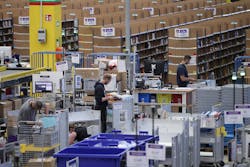Chances are, your company has millions of dollars at risk because the assets you use to run your business are not properly tracked and controlled.
From hand tools to power cords to compressors, we may have a hard time determining if they are with the people or departments that are supposed to be in charge of them. Have they been stolen? Have they been retired, discarded or sold?
According to the Association of Certified Fraud Examiners’ 2014 Report to the Nations on Occupational Fraud and Abuse, more than a third of recorded fraud cases among manufacturers involved the theft of non-cash assets.
Or maybe your assets are right where they should be, but there is no reliable record of that in your accounting systems? Most of us, if we are honest, will admit that we don’t have a firm handle on where all our equipment assets are, who is responsible for them or whether they have been sold or discarded.
We may think this information does not matter to the business, but it does.
As manufacturing or operational professionals charged with leveraging capital assets like equipment, machinery, and tools, we understand assets our companies acquire in terms of their productive purpose. We know how they help us achieve productive purposes, from materials handling equipment to compressors to handheld oscilloscopes to LED lighting arrays.
The accountants in our organization, however, see these same items as assets that must be depreciated, expensed, and accounted for. And while our attitude towards each asset may be "out of sight, out of mind," the accountant can never let an asset out of their sight on the balance sheet. They need to account for assets on a very granular level for a number of reasons. These assets need to be depreciated or expensed to determine the company’s tax liabilities including personal property tax where applicable.
The assets a company owns are also one of the factors banks use in making lending decisions. So if your company wants to expand, purchase new equipment or even borrow money as working capital for minor things like making payroll, you need reliable data on your productive assets.
Modern enterprise resource planning (ERP) software includes extensive functionality for asset management and control. But conflict may still arise because the individuals serving as the manager or custodian of those assets may not have access to complete enough data to satisfy the needs of the individual responsible for accounting for the assets.
Asset management presents us with this conflict between two world views … those of us using equipment to create value and those charged with quantifying that value. It is the stuff that sitcoms are made of. The two parties just don’t get each other, have little shared perspective, and seem to talk past each other. And that is something Panatrack President Michael Burnham may have had in mind when he created this irreverent, humorous take on fixed asset accounting. The resolution, the relief, the punchline to the joke, is the availability of barcode scanning software that updates data in the asset management module in Microsoft Dynamics GP.
It is ultimately up to the operations professionals responsible for the asset on the ground to meet the accounting people in the middle and deliver more accurate asset data.
Implementing a barcode asset management program is essential for a few reasons. It automates the collection of information on assets as they are purchased, placed into service, given to an individual or department or taken out of service or retired. The presence of the barcode tags on the equipment can also act as a theft deterrent because a would-be thief knows the asset is being tracked.
CYA – Cover Your Assets
Implementing barcode asset tags for fixed asset management is not difficult, and the good news is that you can start even before you implement barcode software that feeds data into your accounting systems. You can get asset tags with your company name on them and start placing them on new and existing assets. You’ll want to make sure these tags are durable enough to outlast the asset in question.
As you tag your assets, you are then in a position to select and implement software that will record that asset tag number and store it in the enterprise software used to run your company’s general ledger. You’ll want to make sure your system will capture the critical data about the asset, including the manufacturer, model number, configuration, purchase order, vendor, serial number if applicable, and who the custodian of that asset is.
You will also want to implement processes to scan that asset tag each time new assets are placed into service, anytime the custodianship or location of the asset changes or if the asset is eventually liquidated or retired.
A final recommendation would be to think carefully about how you track your assets—as single items or as part of a batch of assets put into service on the same date. Many ERP products allow you to track assets multiple ways, so identical pieces of equipment purchased at the same time can be depreciated or expensed as a group but managed individually with regard to location and custodianship.
Charles Rathmann is an analyst, journalist, and marketer with more than 20 years of experience, with most of that focused on enterprise software, capital equipment, and engineering. At Panatrack, he helps people appreciate the benefits of automatic data capture (ADC) for inventory management, asset management, and field sales. He holds a degree in journalism from the University of Wisconsin-Oshkosh and works in the Panatrack world headquarters in Hartland, Wis.
